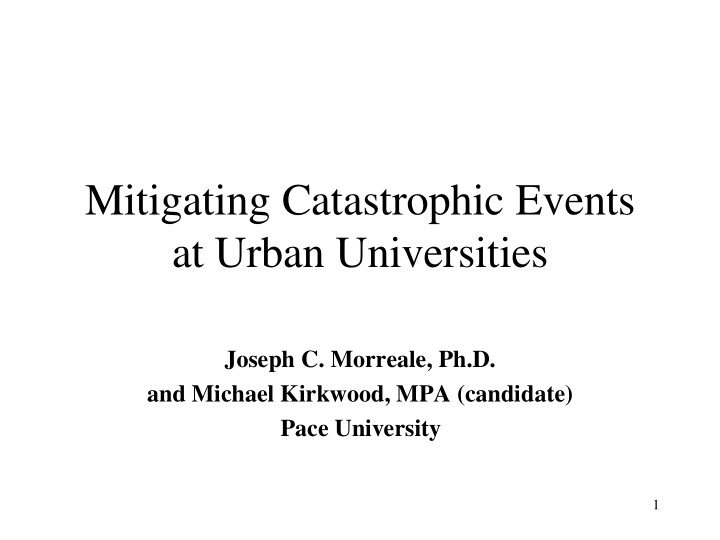



Mitigating Catastrophic Events at Urban Universities Joseph C. Morreale, Ph.D. and Michael Kirkwood, MPA (candidate) Pace University 1
Purpose of the Presentation • To review how several universities have managed unforeseen disasters on their respective campuses • To determine what are the lessons learned from theses experiences • To develop a checklist of strategies to mitigate against such unforeseen catastrophic events The focus here is on urban universities 2
Case Studies • Earthquake: Cal. State U at Northridge (1994) Stanford University (1989) • Floods: University of North Dakota (1997) Colorado State University (1997) University of Houston (2001) • Hurricanes: University of Miami (1992) Tulane University (1998) East Carolina University (1999) • Terrorist Attack: Pace University (2001) Manhattan Borough CC (2001) 3
Mitigating against Disasters Foresight Leadership Planning Resiliency Recovery Preparedness 4
Critical Characteristics of Urban Universities • Academics (Core Business) – Teaching (Classes) – Research (Facilities) – Business Operations • Residential Services (Hotel or Apartments) • Utilities/Telecomms (Utility/Telephone Co.) • Food Service (Restaurant) • Health Care Unit (Medical Facility) • Counseling Services (Psychological Servs.) • Transportation (Bus Company) • Security Services (Police) 5
Key Constituencies: Internal • Students: Residential & Commuting • Parents: Residential & Commuter Students • Faculty: Full-time and Adjunct • Administrators: Senior Officers • University Staff • Board of Trustees Members • Alumni 6
Key Constituencies: External • Prospective Students and Parents • Business and Industry: Doing Business and Surrounding Area • Political Leaders: National, State and Local • Surrounding City Government and Community • The General Public in the metropolitan region • The National Public 7
Key Features of Mitigation: Internal • Create Comprehensive Multi-hazards Emergency Response Plan • Establish a Crisis Response Team • Develop a Communication Strategy • Have a Predetermined Crisis Management Center • Have in place a Business Resumption Disaster Recovery Plan • Make it an Ongoing Continuous Effort 8
Key Features of Mitigation: External • Align University Disaster Recovery Plan with Plans of State and Local Governments and surrounding communities • Make arrangements to use university resources to assist neighboring communities • Foster Communication and Create Agreements with surrounding community or city regarding disaster resistance and planning • Develop cooperative agreements with neighboring institutions of higher education on disaster recovery 9
A Comprehensive Emergency Response Plan • Should encompass multi-hazards • Develop a Strategic Risk Assessment Analysis • Create a Campus Master Facilities Plan • Need Telecommunications and Utilities Plan • Have a Multiphase Response Plan • Have a Facilities Shutdown Plan • Have Evacuation Plans N.B.: Don’t forget the needs of people: Counseling, Financial and Support Services- Who?What?Where?When? 10
Strategic Risk Assessment Examples • Natural Disasters: flood, fire, earthquake, wind damage, snow/ice storm, hurricane • Technical Disasters: power outage, technology failure, explosion, telecommunications failure • Human Disasters: malicious damage, bombings, bomb threats, strikes, sabotage, vandalism Any others that are specific to your area or region 11
Evacuation Plan • Where to relocate faculty, students and staff • Chart evacuation routes • Designate an assembly area outdoors and indoors • Partner with area businesses, residents, other educational institutions and the community • Communication during evacuation 12
Establish a Crisis Response Team • Trained in response techniques • Have a budget to be used for continuing efforts • Membership: students, faculty, staff, administrators and key community people • Have an identified Team Leader • Designate crisis leaders for each building on campus 13
Develop a Communication Strategy: Internal • Internal Communications: Designated Crisis Spokesperson - Should be the President Provide continuous status updates Leadership,Visibility and Accessibility Community Meetings Inspire Executive Team to be Available Target Audience: University Community 14
Develop a Communication Strategy: External • Designate Crisis Spokesperson to manage the Media Should be the Senior Officer for University Relations Offer continuous status updates Provide Leadership and Visibility Be Readily Available Use the public media to get the message out Target Audience: University Community, parents, prospective students, alumni and the general public 15
Communication Strategy • Have in place a 24/7 telephone answering system • Develop a 24 hour hotline number staffed by university personnel – place one Senior Officer in charge • Use email, voice mail, web page, campus newspaper • Have regularly scheduled community meetings • Use the public media to get the message out NB: Make sure that the messages are consistent 16
Have a Predetermined Crisis Management Center • Designated Space on each Campus • Emergency Power Source • Emergency Telecommunications • Locations On and Off Campus • Locations well-know to Senior Officers • Disaster Supply Kit • Periodic Drills on how to run the Command Center 17
Responding to The Community • How can we help? • Hospitals and Health Care • Emergency Services: Police, Fire, EMS • Emergency Volunteers: Red Cross, Salvation Army, etc. • Religious and Secular NGOs 18
Business Resumption Disaster Recovery Plan • Communication Plan for Reopening • Staged Opening of Classes and Staff Reporting • Housing Relocation Plan • Transportation Plan • Enhanced Security: Presence and Visibility • Counseling and Support Services N.B.: On sight Visible Presence of Senior Leadership 19
An Ongoing Continuous Effort • Assess the Disaster Response Efforts: Survey • Have Periodic Drills throughout the university to Test Emergency Response Plan • Offer ongoing/information programs on disaster resistance • Have Crisis Management Team revisit Emergency Response and Disaster Recovery Plans Periodically (every year) 20
Memorializing the Event • Bring closure to the catastrophic event • Survey the internal community on the disaster response and communicate results • Have a closing ceremony acknowledging those lost and those who served • Establish a permanent memorial to the event 21
Mitigating Catastrophic Events at Urban Universities Joseph C. Morreale, Ph.D. and Michael Kirkwood, MPA (candidate) Pace University 22
Recommend
More recommend